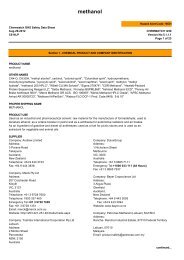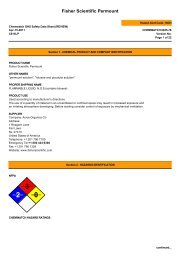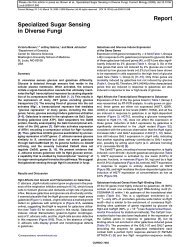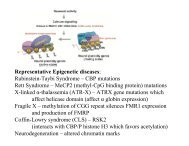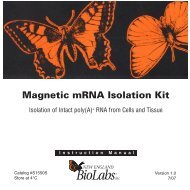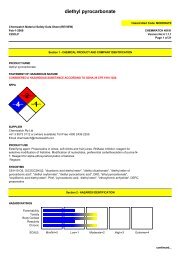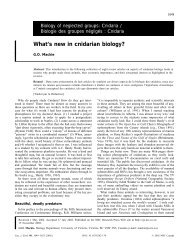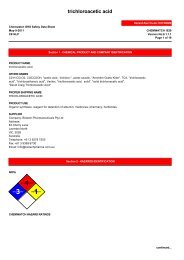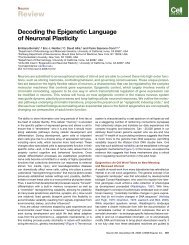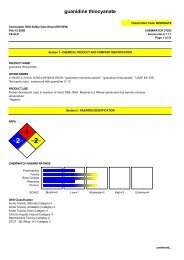Inhibition of lactate dehydrogenase A induces oxidative stress and ...
Inhibition of lactate dehydrogenase A induces oxidative stress and ...
Inhibition of lactate dehydrogenase A induces oxidative stress and ...
- No tags were found...
Create successful ePaper yourself
Turn your PDF publications into a flip-book with our unique Google optimized e-Paper software.
Supporting InformationLe et al. 10.1073/pnas.0914433107SI Experimental ProceduresCell Lines <strong>and</strong> Hypoxic Exposure. P493 human lymphoma B cells weremaintained in RPMI 1640 with 10% (vol/vol) FBS <strong>and</strong> 1% (wt/vol)penicillin–streptomycin. P198 human pancreatic cancer cells,RCC4 <strong>and</strong> RCC4-VHL human renal carcinoma cells, <strong>and</strong> MCF-7<strong>and</strong> MDA-MB-453 breast cancer cells were maintained in highglucose(4.5 mg/mL) DMEM with 10% (vol/vol) FBS <strong>and</strong> 1% (wt/vol) penicillin–streptomycin. Nonhypoxic cells (20% (vol/vol) O 2 )were maintained at 37 °C in a 5% (vol/vol) CO 2 <strong>and</strong> 95% (vol/vol)air incubator. Hypoxic cells (1% O 2 ) were maintained in a controlledatmosphere chamber (PLAS-LABS) with a gas mixturecontaining 1% O 2 , 5% (vol/vol) CO 2 , <strong>and</strong> 94% (vol/vol) N 2 at37 °C for the indicated time. Bright live cells were counted dailyin a hemacytometer using trypan blue dye to exclude dead cells. Allcells were grown at a concentration <strong>of</strong> 10 5 cells /mL. All drug treatmentsbegan at day 0. FX11 was added daily.RNA Interference Experiments. siRNAs targeting human LDHA(ON-TARGETplus SMARTpool) were purchased from DharmaconResearch, Inc. Targeting sequences for LDHA were a pool<strong>of</strong> the following four target sequences: sequence 1, GGAGAA-AGCCGUCUUAAUU; sequence 2, GGCAAAGACUAUA-AUGUAA; sequence 3, UAAGGGUCUUUACGGAAUA; <strong>and</strong>sequence 4, AAAGUCUUCUGAUGUCAUA. For P493 humanlymphoma B cells, transfection <strong>of</strong> siRNAs was performed using anAmaxa Nucleotransfection device according to the manufacturer’sinstructions. Briefly, 2 μg <strong>of</strong> siLDHA ON-TARGETplus SMARTpoolor ON-TARGETplus Nontargeting Pool (Dharmacon Research,Inc.) was transfected into 2 × 10 6 cells at 0 h. At 24 h, 10 5 cellswere treated with 0.1% DMSO or FX11 for 48 more hours. Theremaining cells were harvested for immunoblot analysis. For P198human pancreatic cancer cells, transfection <strong>of</strong> siRNAs was performedusing X-tremeGENE siRNA Transfection Reagent (Roche)according to the manufacturer’s instructions.Western Blot Analysis. Cell pellets were harvested after washingwith PBS. Protein concentration was determined by BCA assay(Pierce) <strong>and</strong> 30 μg <strong>of</strong> protein per well was separated by SDS/PAGE <strong>and</strong> transferred by iBlot gel transfer stacks (Invitrogen).Rabbit monoclonal anti-LDHA (Epitomics) was used to detecthuman LDHA; phosphor-AMP kinase α <strong>and</strong> phospho-acetyl-CoA carboxylase antibodies were purchased from Cell Signaling.Membranes were reprobed with anti-α-tubulin as a loadingcontrol. The enhanced chemiluminescence reagent ECL (GEHealthcare) was used for detection.Oxygen Consumption. Oxygen consumption was measured using aClark-type oxygen electrode (Oxytherm System; HansatechInstruments Ltd). Then, 5 × 10 6 cells in 1 mL <strong>of</strong> medium wereplaced in the chamber above a membrane that is permeable tooxygen. Oxygen diffuses through the membrane <strong>and</strong> is reduced atthe cathode surface so that a current flows through the circuit,which is completed by a thin layer <strong>of</strong> KCl solution. The current thatis generated bears a direct stoichiometric relation to the oxygenreduced <strong>and</strong> is converted to a digital signal. Determinations weredone in triplicate, <strong>and</strong> the entire experiment was done twice.ROS Measurement by Flow Cytometry. Intracellular ROS productionwas measured by staining cells with 5-(<strong>and</strong>-6)-carboxy-2′,7′-dichlorodihydr<strong>of</strong>luorescein diacetate (carboxy-H 2 DCFDA;Molecular Probes) according to the manufacturer’s instructions.Next, 10 5 cells/mL were treated with 9 μM FX11 or 0.5 nMFK866 for 24 h. Stained cells were analyzed in FACScan flowcytometers (BD Bioscience).Annexin V Assay. After 24 h <strong>of</strong> FX11 treatment, cells were harvested<strong>and</strong> washed twice with cold PBS <strong>and</strong> the assay was performedusing the Annexin V–7-AAD apoptosis detection Kit I(BD Biosciences Pharmingen) according to the manufacturer’sinstructions.Determination <strong>of</strong> K i <strong>and</strong> Enzyme Kinetics. The reaction velocity <strong>of</strong>purified human LDHA or GAPDH was determined by a decreaseor increase, respectively, in absorbance at 340 nm <strong>of</strong> NADH. TheLDHA activity was assessed using the protocol described in theWorthington Enzyme Manual, with varying concentrations <strong>of</strong>NADH. The GADPH activity was assessed using the protocoldescribed in the Worthington Enzyme Manual with varying concentrations<strong>of</strong> NAD + . K i values were determined from doublereciprocalplots by linear regression analysis using SigmaPlotEnzyme Kinetic s<strong>of</strong>tware.CarboxyLink Immobilization <strong>and</strong> Affinity Columns. FX11 <strong>and</strong> Emolecules that contain carboxyl groups were coupled to immobilizeddiaminodipropylamine resins according to the manufacturer’sinstructions (Pierce). About 1.9 mg (95% couplingefficiency) <strong>of</strong> FX11 or E was coupled to 2 mL <strong>of</strong> resin as estimatedby the amount <strong>of</strong> either molecule recovered after conjugation.An equal amount <strong>of</strong> cell lysate was loaded onto thesebeads <strong>and</strong> eluted with 1 mM NADH after washing with six columnvolumes <strong>of</strong> high salt (1 M NaCl). LDHA activity was performedfrom the eluates to assess the binding affinity <strong>of</strong> themolecules with LDHA.Mitochondrial Membrane Potential Measurement by Flow Cytometry.The lipophilic cation dye [JC-1(5,5′,6,6′-tetrachloro-1,1′,3,3′-tetraethylbenzimidazolcarbocyanine iodide); Invitrogen) wasused to detect the loss <strong>of</strong> the mitochondrial membrane potential.The negative charge established by the intact mitochondrialmembrane potential lets the lipophilic dye stain the mitochondriabright red, which emits in channel 2 (FL2). When the mitochondrialmembrane potential collapses, JC-1 remains in thecytoplasm in a green fluorescent monomeric emission in channel1 (FL1). JC-1 reversibly changes its color from green to orangeas membrane potentials increase (over values <strong>of</strong> 80–100 mV).Then, 10 5 cells/mL were treated with 9 μM FX11 <strong>and</strong>/or FK866for 24 h. Stained cells were analyzed in FACScan flow cytometers(BD Bioscience).Measurement <strong>of</strong> ATP. P493 cells were treated with 9 μM FX11 or0.5 nM FK866 for 20 h <strong>and</strong> counted. ATP levels were determinedby a luciferin–luciferase-based assay (Promega) onaliquots containing equal number <strong>of</strong> cells according to a st<strong>and</strong>ardprotocol.Determination <strong>of</strong> NADH/NAD + <strong>and</strong> NADPH/NADP + Ratios. The NADH/NAD + <strong>and</strong> NADPH /NADP + ratios were assessed using theprotocol described by the manufacturer. The assay is based on anenzyme-catalyzed kinetic reaction in which a tetrazolium dye 3-[4,5-dimethylthiazol-2-yl]-2,5-diphenyltetrazolium bromide is reducedby NAD(P)H in the presence <strong>of</strong> phenazine methosulfate.The intensity <strong>of</strong> the reduced product color, measured at 565 nm, isproportionate to the NAD(P)H /NAD(P) + concentration in thesamples. The NAD(P)H or NAD(P) + content <strong>of</strong> the cells washarvested separately using a corresponding extraction buffer.Le et al. www.pnas.org/cgi/content/short/09144331071<strong>of</strong>11



